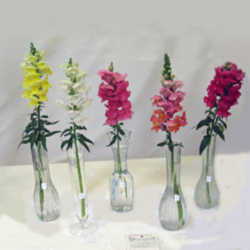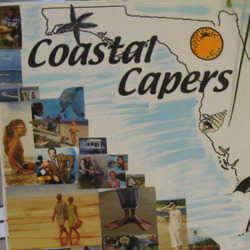The first step in determining who can enter a Standard Flower Show is obtaining a copy of the Schedule. The Schedule is the "law of the show," and all exhibitors are bound by these laws. One of the first bits of information listed in the Schedule is who is allowed to enter. In many instances, such as county fairs and public venues, anyone is welcome to enter. In other shows, only club members are allowed to enter. At any rate, the Schedule will determine who can or cannot enter.
How Do I Find Out All the Details? 
Cut arboreal exhibit
When you obtain a copy of the Schedule, read it through carefully. It contains such necessary information as the location of the show, the times when horticulture specimens can be entered, when judging is to take place, when it is open to the public, and when the show is to be dismantled. The Schedule announces all sections and classes as well as rules which govern all exhibits in each division. There are general rules, horticulture division rules, and design division rules. Every Schedule is different, but horticulture rules for my club's flower show are in a chart below and will give you an idea of what to expect.
The Schedule explains what kind of specimens are accepted, how they are to be staged, how long a specimen should have been in your possession, and other pertinent facts. The schedule also states whether the show committee provides bottles for your cut specimens or if you should bring your own, which awards are being offered, and other useful information.
The Horticulture Division  |
Cut flower of herbaceous perennial |
The Horticulture Division of a Standard Flower Show is divided into several different sections. Within each section are classes. Sections are stated in the Flower Show Schedule that has been published. Most Standard Flower Shows have many sections, but almost all of the plants that I can think of can fit in one of these sections:
Section A: Cut flowers of annuals or biennials
Section B: Cut flowers of herbaceous perennials
Section C: Cut flowers or bracts of bulbs, rhizomes, corms, and tubers
Section D: Cut decorative foliage
Section E: Arboreal (fresh cut branches of evergreen or deciduous shrubs or trees grown for the beauty of foliage, flowers, fruit, or cones)Section F: Combination Plantings
Section G. Container-Grown Plants
Section H: Collections and Displays
In addition, a flower show committee may wish to have sections for special groups of plants, such as roses, daffodils, camellias, succulents, bromeliads, etc. Even though these fit into one of the categories above, there may be enough of them to warrant having their own section.
How Can I Learn More?
In subsequent articles, I will go more into depth about each of the sections listed above. NGC has very specific definitions as to what constitutes appropriate specimens in each section. For instance, a dish garden may mean something different to each person, but NGC defines it specifically, and failing to know the definition can result in points being taken from your exhibit. A little learning goes a long way in making your flower show experiences rewarding.
 |  |  |
| Container-grown flowering plant | Container-grown foliage plant | Cut flower of bulb |
Horticulture Rules
|
















